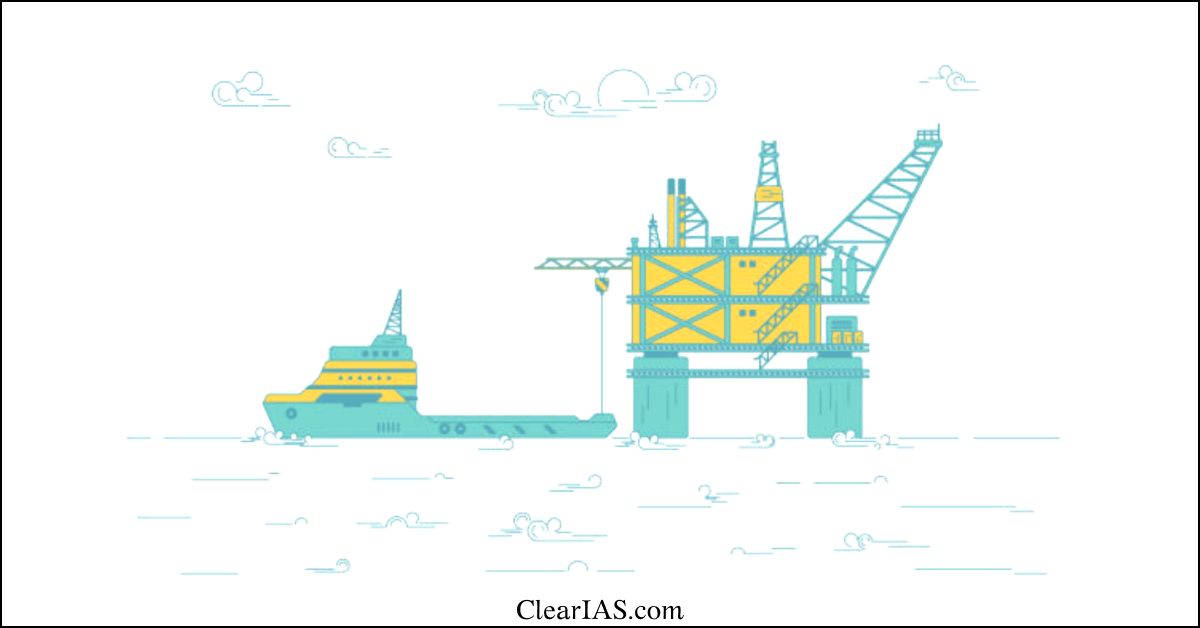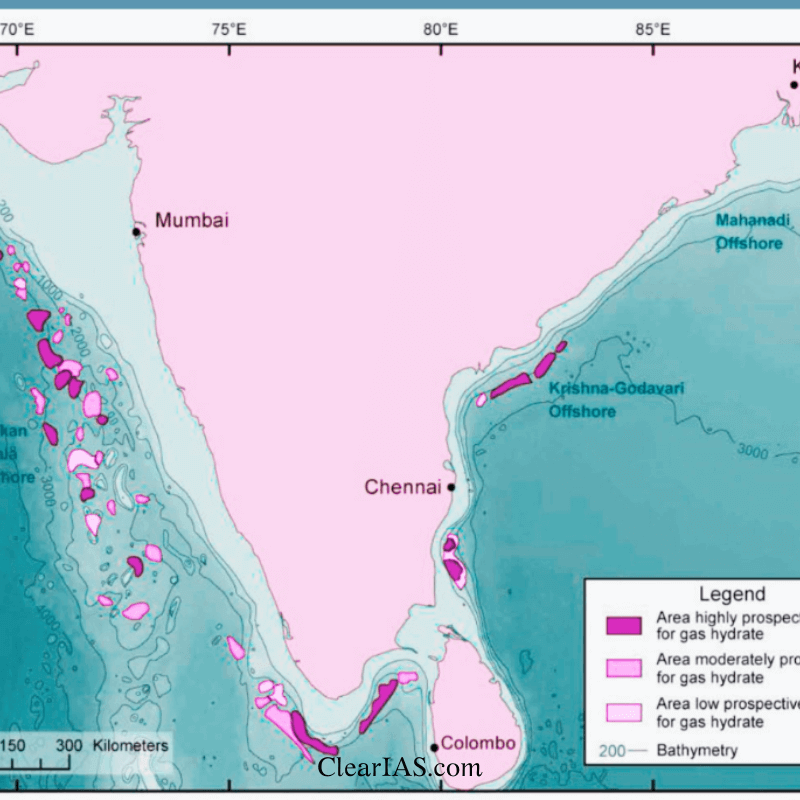 What are natural gas hydrates? Where are its reserves located in India and what challenges are associated with them? Read here.
What are natural gas hydrates? Where are its reserves located in India and what challenges are associated with them? Read here.
Natural gas hydrates are a mixture of ice-like forms of water and gas in molecular cavities.
As a result of their abundance and benefits in addressing upcoming energy-related challenges, natural gas hydrates are gaining more and more attention in the energy sector.
The world has been facing an energy crisis with a consistent rise in oil prices. Need to know more click here.
Also read: Methane Emissions
Natural Gas Hydrate Reserves in India
- Krishna-Godavari (KG)
- Cauvery
- Kerala basin
- Andaman sea
- Konkan basin

Significance of Natural Gas Hydrates:
- Marine carbon dioxide sequestration: By forming complexes with carbon dioxide, gas hydrates can be used to sequester carbon dioxide.
- Sustainable energy resource: The world can eventually turn to gas hydrate as a sustainable energy source due to its abundance and less-polluting nature.
- Abundance: More energy is believed to be stored in hydrate reserves than in coal, conventional gas, and petroleum reserves combined, making up more than twice that amount.
- Storing and transporting natural gas: Gas hydrates have the potential to be an effective and efficient alternative for bulk gas transportation and storage for future use.
- Cold storage and air conditioning: The use of hydrate energy is unquestionably pertinent for the field of air conditioning because the temperature at which the hydrates phase change is above the freezing point of water.
- Gas Separation process: Hydrate formation allows for the separation of nitrogen, carbon dioxide, and hydrogen sulphide from methane.
- Carbon cycle: Since they are thought to contain between 5 and 22% of all the organic carbon on Earth, natural gas hydrates play a significant role in the carbon cycle.
- Desalination of seawater: When fresh water is produced in a temperature-controlled vessel through the use of gas hydrate, it can be desalinated from seawater.
- Hydrate as a Fresh Water Resource: Freshwater makes up 0.8 volumes of each volume of gas hydrate.
Challenges associated:
There are multiple challenges associated with this like, geophysical challenges, environmental challenges, economical challenges and technological challenges etc.
Geophysical Challenges
- Hydrate dissociation-induced strength loss: Because of the strength loss of the seabed caused by hydrate extraction, large-scale slope failures occur.
- High-pressure drawdown: The withdrawal of gas from a producing well causes a drop in reservoir pressure, which leads to pressure decline in the reservoir and eventual pressure depletion.
- Sand migration: During gas production, there is a possibility of sand migration in hydrate-bearing sediments interbedded with mud layers.
Environmental Challenges
- Damage to sensitive chemosynthetic communities: Sensitive chemosynthetic communities may be harmed by the extraction of gas hydrate.
- Affect marine ecosystem: The exploitation of hydrate sediments under unfavourable conditions could significantly alter the marine ecosystem and even result in underwater gas blowouts.
- Climate change: The role of destabilizing hydrate sediments in climate change is undeniable. Slight global warming would raise the temperature of the hydrate above the equilibrium point, resulting in dissociation and the release of a large amount of methane.
Economical Challenges
- High shipping cost: Gas hydrates are expensive to ship because 6.5 tonnes of water are shipped along with every tonne of natural gas, even though the water has no economic value.
- Commercial viability: Only when the cost of conventional hydrocarbon and other fuels increases significantly will the extraction of methane hydrates be economically feasible.
- Economic competitiveness: The ability of gas hydrates to compete economically with conventional resources could be a problem.
- Need for huge capital investment: Massive investments are required in technology, transportation, and gas hydrate research to produce gas hydrates.
Technological Challenges
- Non-compatibility of existing technologies: The formation itself and its surroundings would be affected if natural gas were to be extracted from hydrate formations using currently used methods.
- Identification and quantification of reserves: Seismic techniques, the primary tool used by the oil industry, are difficult to use in the detection of natural gas hydrates.
- Drilling and completion (stimulation) technology development: Because of the hydrates’ characteristics, particularly their tendency to be brittle, drilling for methane recovery from them is a difficult task. Drilling could cause hydrates to separate, which could lead to an uncontrolled gas release and cause the site to sink.
Measures were taken by the Government
- National Gas Hydrate Programme (NGHP): Given India’s phenomenally increasing energy demand, the National Gas Hydrate Programme (NGHP) is significant on a national level.
A steering committee and a technical committee of NGHP were established to implement the program when it was first launched in 1997. Based on the Technical Committee’s review of seismic data, two areas in Indian waters, one along the East Coast and the other along the West Coast, have been designated as “Model Laboratory Areas” for additional R&D work. - Dedicated gas hydrate research centre at Panvel: On July 6, 2016, ONGC established the Gas Hydrate Research & Technology Centre (GHRTC) at the ONGC Complex in Panvel.
- Agreement with the USA, Canada, and Japan: India had agreed to work with the United States, Canada, and Japan to investigate gas hydrates.
- Initiatives of GAIL and IIT Madras: IIT Madras, in collaboration with GAIL, is working to recover methane from methane hydrate in the Krishna-Godavari basin while also sequestering CO2.
Way forward
- Research and Modeling: Before drilling, India must come up with creative ways to identify where and how much methane hydrate is subsurface. The government is also carrying out research to comprehend the physical characteristics of strata that contain gas hydrates and to model this understanding at the reservoir scale to forecast future behaviour and production.
- Sustainable production and use: Gas hydrates must be produced and used in a sustainable manner while protecting the marine environment.
- International Collaboration: Due to the fact that gas hydrates present both research challenges and resource potential that are significant on a global scale, international collaboration is still an essential component of the program.
- Study of Production Feasibility: Large amounts of methane hydrates can be found offshore and beneath the permafrost. It is necessary to conduct a study to evaluate the potential effects on the environment of producing natural gas from hydrates.
- Greater need for academic institution efforts to explore gas hydrates: In order to step up efforts in the exploration of gas hydrate horizons, there should be greater involvement of academic researchers.
In the far future, natural gas hydrates present a reliable energy source. The difficulties in producing these resources have been acknowledged.
However, given that the population is expanding and conventional energy sources are depleting, there will also be a need for these energy sources.
Energy politics and policies will undoubtedly change as a result of the production of these resources, possibly even turning nations that currently import gas into exporters.
Article Written by: Remya








Leave a Reply